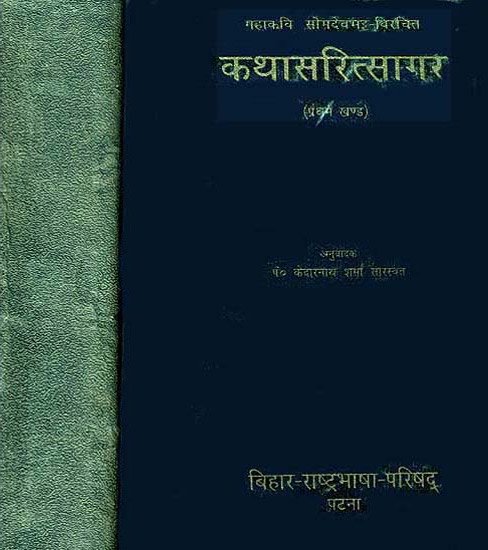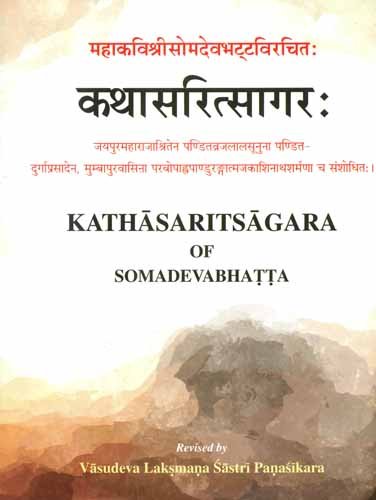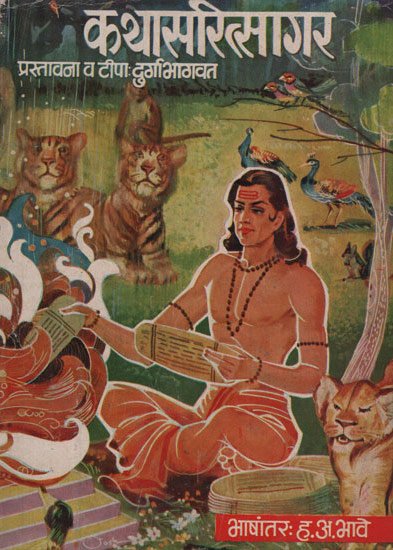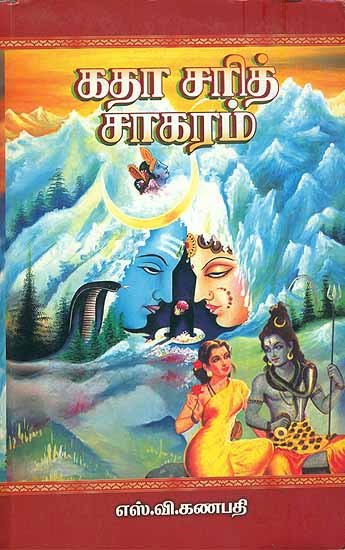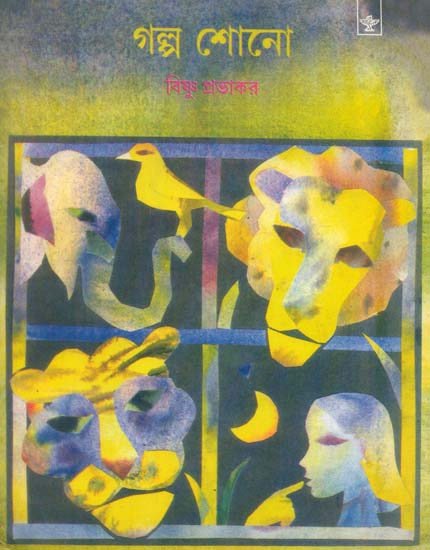Kathasaritsagara [sanskrit]
by C. H. Tawney | 2014 | 226,424 words | ISBN-13: 9789350501351
The Sanskrit edition of the Kathasaritsagara referencing the English translation and grammatical analysis. Written by Somadeva and dating from the 12th century, the Kathasaritsagara (or Katha-sarit-sagara) represents an epic legend narrating the adventures of Naravahanadatta as he strives to become the destined emperor of the Vidyadharas. Alternative titles: (Kathāsaritsāgara, कथासरित्सागर, Kathā-sarit-sāgara)
Verse 9.2.111
ताभ्यां कथमहं दद्यामात्मानं क्षत्रिया सती ।
तृतीयस्तुल्यवर्णो मे भवति क्षत्रियो गुणी ॥ ११० ॥
tābhyāṃ kathamahaṃ dadyāmātmānaṃ kṣatriyā satī |
tṛtīyastulyavarṇo me bhavati kṣatriyo guṇī || 110 ||
The English translation of Kathasaritsagara Verse 9.2.111 is contained in the book The Ocean of Story by C.H. Tawney. This book is available online or you could buy the latest edition:
Read online Buy now! The English translation by C.H. Tawney (2014)
Glossary of Sanskrit terms
Note: This extracts Sanskrit terms and links to English definitions from the glossary, based on an experimental segmentation of verse (9.2.111). Some terms could be superfluous while some might not be mentioned. Click on the word to show English definitions.
Tad, Katham, Katha, Aha, Asmad, Atman, Kshatriya, Sat, Sati, Tritiya, Tulya, Varna, Bhavati, Bhavat, Bhavant, Gunin, Guni,
Analysis of Sanskrit grammar
Note: this is an experimental feature and only shows the first possible analysis of the Sanskrit text (Kathasaritsagara Verse 9.2.111). If the system was successful in segmenting the sentence, you will see of which words it is made up of, generally consisting of Nouns, Pronouns, Verbs, Participles and Indeclinables. Click on the link to show all possible derivations of the word.
- Line 1: “tābhyāṃ kathamahaṃ dadyāmātmānaṃ kṣatriyā satī ”
- tābhyām -
-
ta (noun, masculine)[instrumental dual], [dative dual], [ablative dual]ta (noun, neuter)[instrumental dual], [dative dual], [ablative dual]tā (noun, feminine)[instrumental dual], [dative dual], [ablative dual]tad (noun, neuter)[instrumental dual], [dative dual], [ablative dual]sa (noun, masculine)[instrumental dual], [dative dual], [ablative dual]sā (noun, feminine)[instrumental dual], [dative dual], [ablative dual]
- katham -
-
katham (indeclinable interrogative)[indeclinable interrogative]katham (indeclinable)[indeclinable]kathā (noun, feminine)[adverb]katha (noun, masculine)[adverb], [accusative single]katha (noun, neuter)[adverb], [nominative single], [accusative single]
- aham -
-
aha (noun, neuter)[adverb], [nominative single], [accusative single]asmad (pronoun, none)[nominative single]
- dadyāmā -
-
√dā (verb class 3)[optative active first plural]
- ātmānam -
-
ātman (noun, masculine)[accusative single]
- kṣatriyā -
-
kṣatriyā (noun, feminine)[nominative single]
- satī -
-
satī (noun, feminine)[compound], [nominative single]sat (noun, neuter)[nominative dual], [vocative dual], [accusative dual]sati (noun, feminine)[nominative dual], [vocative dual], [accusative dual]
- Line 2: “tṛtīyastulyavarṇo me bhavati kṣatriyo guṇī ”
- tṛtīyas -
-
tṛtīya (noun, masculine)[nominative single]
- tulya -
-
tulya (noun, masculine)[compound], [vocative single]tulya (noun, neuter)[compound], [vocative single]√tul -> tulya (participle, masculine)[vocative single from √tul class 10 verb]√tul -> tulya (participle, neuter)[vocative single from √tul class 10 verb]
- varṇo* -
-
varṇa (noun, masculine)[nominative single]
- me -
-
ma (noun, masculine)[locative single]ma (noun, neuter)[nominative dual], [vocative dual], [accusative dual], [locative single]mā (noun, feminine)[nominative dual], [vocative single], [vocative dual], [accusative dual]asmad (pronoun, none)[dative single], [genitive single]
- bhavati -
-
bhavatī (noun, feminine)[adverb], [vocative single]bhavat (noun, masculine)[locative single]bhavat (noun, neuter)[locative single]bhavant (pronoun, masculine)[locative single]bhavant (pronoun, neuter)[locative single]√bhū (verb class 1)[present active third single]
- kṣatriyo* -
-
kṣatriya (noun, masculine)[nominative single]
- guṇī -
-
guṇī (noun, masculine)[compound]guṇī (noun, feminine)[compound], [nominative single]guṇin (noun, masculine)[nominative single]
Other editions:
Also see the following editions of the Sanskrit text or (alternative) English translations of the Kathasaritsagara Verse 9.2.111
Kathasaritsagar
by Kedarnath Sharma Saraswat (2005)
The Only Edition with the Sanskrit Text and its Hindi Translation (An Old and Rare Book) Set of 3 Vol.
Buy now!
Kathasaritsagara of Somadeva Bhatta (Sanskrit Text Only)
by Vasudeva Laksmana Sastri (2013)
Katha Sarit Sagar in Marathi
by H. A Bhave (1995)
Set of 5 Volumes; Published by Varada Books, Pune. 2256 pages (Throughout B/W Illustrations).
Buy now!
Katha Sarit Sagara (Tamil)
by S. V. Ganapati (எஸ். வி. கணபதி) (2014)
[கதா சரித் சாகரம்] Published by Alliance Publications.
Buy now!
Galpa Shono
by Abhijit Chattopadhyay (2014)
[গল্প শোনো] Galpa Shono: Bengali Translation of 'Suno Kahani From Katha Sarit Sagar'; 9788126015436; Published by Sahitya Akademi, Delhi.
Buy now!Preview of verse 9.2.111 in Bengali sript:
তাভ্যাং কথমহং দদ্যামাত্মানং ক্ষত্রিযা সতী ।
তৃতীযস্তুল্যবর্ণো মে ভবতি ক্ষত্রিযো গুণী ॥ ১১০ ॥
![Kathasaritsagara [sanskrit] - book cover](/uploads/a/Katha-Sarit-Sagara.jpg)
